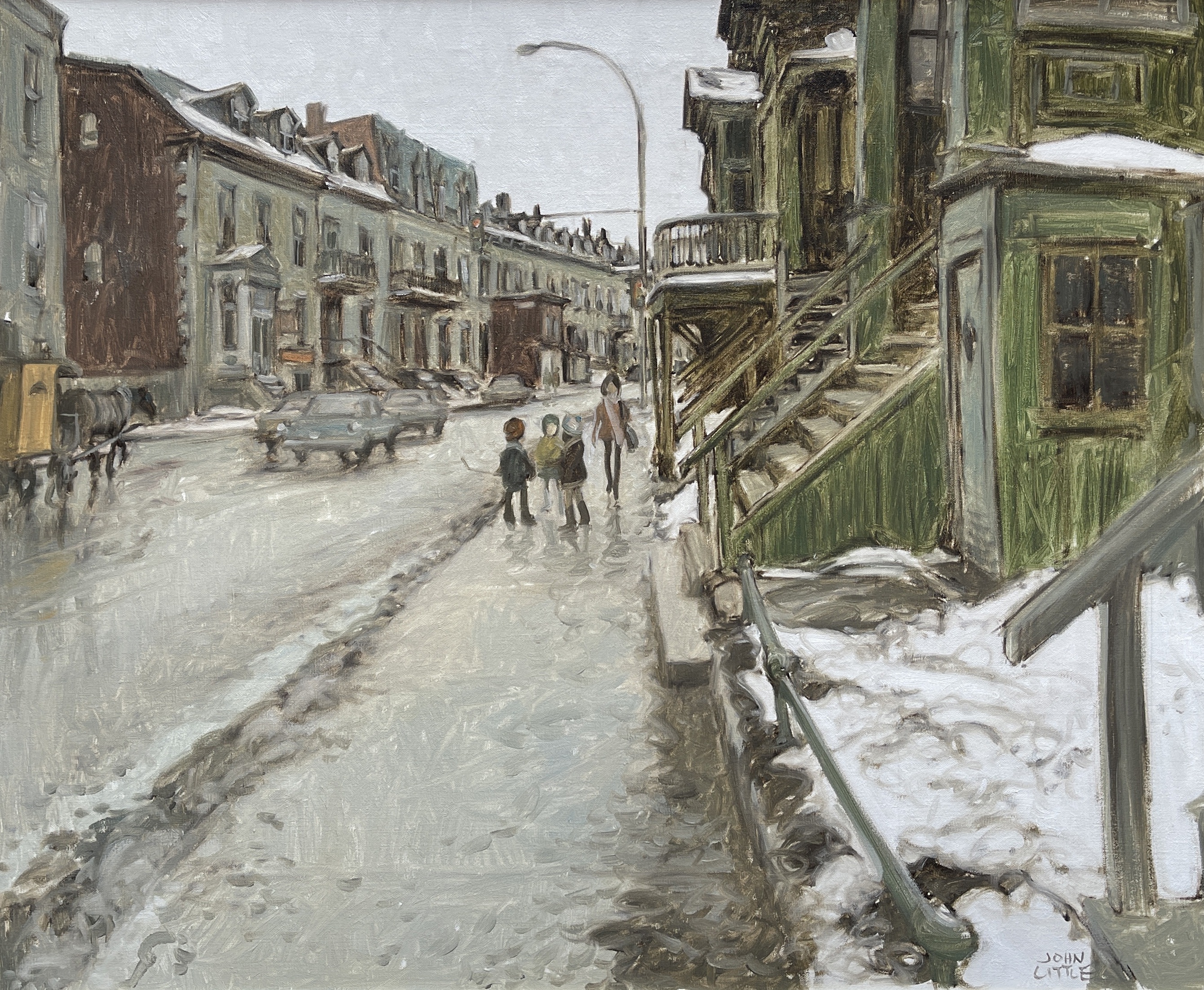John Little and suburbanization - St. Antoine Street At Fulford, St. Henri.
John Little. St. Antoine Street at Fulford, St. Henri, Montreal, 1972.
The right-hand side of Little's St. Antoine Street was totally demolished for Montreal's 720, or Ville-Marie Expressway. The area was forever changed, the neighbourhood scarred, redefined and in part demolished for the benefit of expressway construction. In 1970, in the specific debate about the construction and social cost of the expressway in the area of Little's St. Antoine Street, one of the community activist groups formed 'Operation St. Antoine' opposed to the design." Operation St. Antoine poured over plans, talked with consulting engineers, and anyone remotely connected with the strange decision to route the access ramp through (local resident) Mrs. Martin's living room." (1) The group expressed that, "The time has come to decide whether Highway Men will continue to determine the social or physical parameters for our environment..." (2) Robinson quotes Joseph Baker, Co Chairman of the Housing and Urban Renewal Committee and former president of the Province of Quebec Association of Architects and Director of the Community Design Workshop at McGill School of Architecture.
John Little is extraordinarily unique among artists in North America in his generation. During the Post World War ll period of suburbanization and “urban renewal” which saw downtown neighbourhoods changed, some even razed for the “benefit” of new highways leading to and from the developing suburbs, Little sensed this ill-conceived. Although he did not have an alternate position to offer, he did have the foresight to preserve some of these streets in the only way he could. With cause, we previously referred to John Little as the Jane Jacobs of painting.
As recently as May 27, 2021, the New York Times included an article titled, “Can Removing Highways Fix America’s Cities?” By Nadja Popovich, Josh Williams and Denise Lu which summed up the problem in the American context, one the same as that of Canadian cities. The piece also broaches some of the contemporary solutions to the social issues the highway development caused. “In the past, ‘we created a way for people to get on a highway and go directly out of our community,’ she said, adding that highways also created ‘barriers that were really detrimental to the communities left behind.” (3) This is a quote from Lovely Warren, Mayor of Rochester NY published in The New York Times on May 27, 2021. Since the early 1950s, John Little has been saying very much of this in his paintings.
“Built in the 1950s to speed suburban commuters to and from downtown, Rochester’s Inner Loop destroyed hundreds of homes and businesses, replacing them with a broad, concrete trench that separated downtown from the rest of the city…” (4) (Montrealers can replace the Inner Loop with the Decarie Expressway and Ville-Marie. Torontonians will consider the Gardiner and Don Valley Parkway).
“In order to accommodate cars and commuters, many cities ‘basically destroyed themselves,’ said Norman Garrick, a professor at the University of Connecticut who studies how transportation projects have reshaped American cities.” (5)
Popovich, Williams and Lu write that the highway development tended to disrupt and disfigure, sometimes even displace Black and minority communities. In Little’s painting places, the expropriations and subsequent development generally targeted areas or streets inhabited by lower income residents, citizens without the financial and political clout of options where more affluent citizens would be affected.
“Now, Rochester is trying a different approach: Instead of moving people in and out of downtown as quickly as possible, the city is trying to make downtown a more livable place.” (6)
Keeping downtown a livable place has been John Little’s mantra since the 1950s!
____________________________
Footnote:
1. Joseph Baker, “Architect feels ‘real priorities’ ignored in autoroute planning,” The Montréal Star, 2 January 1971, quoted in Danielle Robinson, “‘The Streets Belong to the People’: Expressway Disputes in Canada, C. 1960-75” (Thesis: McMaster, 2012), 267
2. Ibid
3. Nadja Popovich, Josh Williams, and Denise Lu, “Can Removing Highways Fix America’s Cities?,” The New York Times, May 27, 2021. Accessed July 6, 2021. https://www.nytimes.com/interactive/2021/05/27/climate/us-cities-highway-removal.html?action=click&module=Top Stories&pgtype=Homepage.
4. Ibid.
5. Ibid.
6. Ibid.






Add a comment